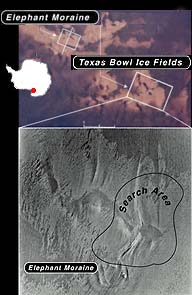| . |  |
. |
|
Nomad 2000 Search Area  Pittsburg - January 17, 2000
Pittsburg - January 17, 2000The robotic search for meteorites is taking place at Elephant Moraine, a remote area in eastern Antarctica, 160 miles northwest of the United States base at McMurdo Station. Nomad and the Carnegie Mellon/ANSMET team were transported to the site from NSF's staging ground at McMurdo via light aircraft and helicopter. Nomad will perform autonomous searches and classification of rock samples at Elephant Moraine in an effort to discover meteorites. Its search will include driving, looking, choosing and testing to select meteorite candidates it encounters in the area. The robot will use high- resolution imagery and spectroscopy to gather scientific data about the rocks it finds. Its arm will enable precise placement of the scientific instruments on the rocks it chooses to study. The ANSMET member of the field team will serve as a guide to the region and collect any meteorites that Nomad successfully locates. The expedition will last about three weeks, depending on the weather. Elephant Moraine looks like a small elephant with a very long trunk. It's considered to be one of the more important sites for meteorite discovery, with nearly 2,000 specimens recovered during seven previous visits, including the first meteorite identified as definitely being from Mars. This year's expedition takes place near the end of the "elephant's trunk," which was last searched in 1979. Nomad has been programmed with navigation strategies for driving. It will move in patterns similar to those people use when they're operating a lawn mower. As it moves, machine vision will enable it to search for rocks distinguished by their dark color against the white ice background.
"The compelling element of this expedition is the prospect of meteorite discovery by a robot," Apostolopoulos said. "Nomad will demonstrate for the first time the ability of a science robot to autonomously search for and distinguish meteorites from terrestrial rocks. "Robotic technologies demonstrated by this project could set a new precedent on the state of the art in space robotics and impact how missions to the planets are designed and carried out," added Apostolopoulos. As the expedition in Antarctica unfolds, the public will be able to follow the action on the Web. Southwestern Pennsylvania K-12 science students and teachers will follow Nomad's adventures in real time through Carnegie Mellon's interactive Web site known as the Big Signal Project.
This is Nomad's third trip to a locale on Earth analogous to an extraterrestrial world. In the summer of 1997, it made an unprecedented 130-mile trek through the Atacama Desert in Chile while being teleoperated by researchers in Pittsburgh and at NASA's Ames Research Center. Last winter, it was taken to Patriot Hills in the Chilean section of Antarctica, where its navigation capabilities were tested under polar conditions.
ROBOSPACE
|
| |||||||||
| The content herein, unless otherwise known to be public domain, are Copyright 1995-2016 - Space Media Network. All websites are published in Australia and are solely subject to Australian law and governed by Fair Use principals for news reporting and research purposes. AFP, UPI and IANS news wire stories are copyright Agence France-Presse, United Press International and Indo-Asia News Service. ESA news reports are copyright European Space Agency. All NASA sourced material is public domain. Additional copyrights may apply in whole or part to other bona fide parties. Advertising does not imply endorsement, agreement or approval of any opinions, statements or information provided by Space Media Network on any Web page published or hosted by Space Media Network. Privacy Statement All images and articles appearing on Space Media Network have been edited or digitally altered in some way. Any requests to remove copyright material will be acted upon in a timely and appropriate manner. Any attempt to extort money from Space Media Network will be ignored and reported to Australian Law Enforcement Agencies as a potential case of financial fraud involving the use of a telephonic carriage device or postal service. |